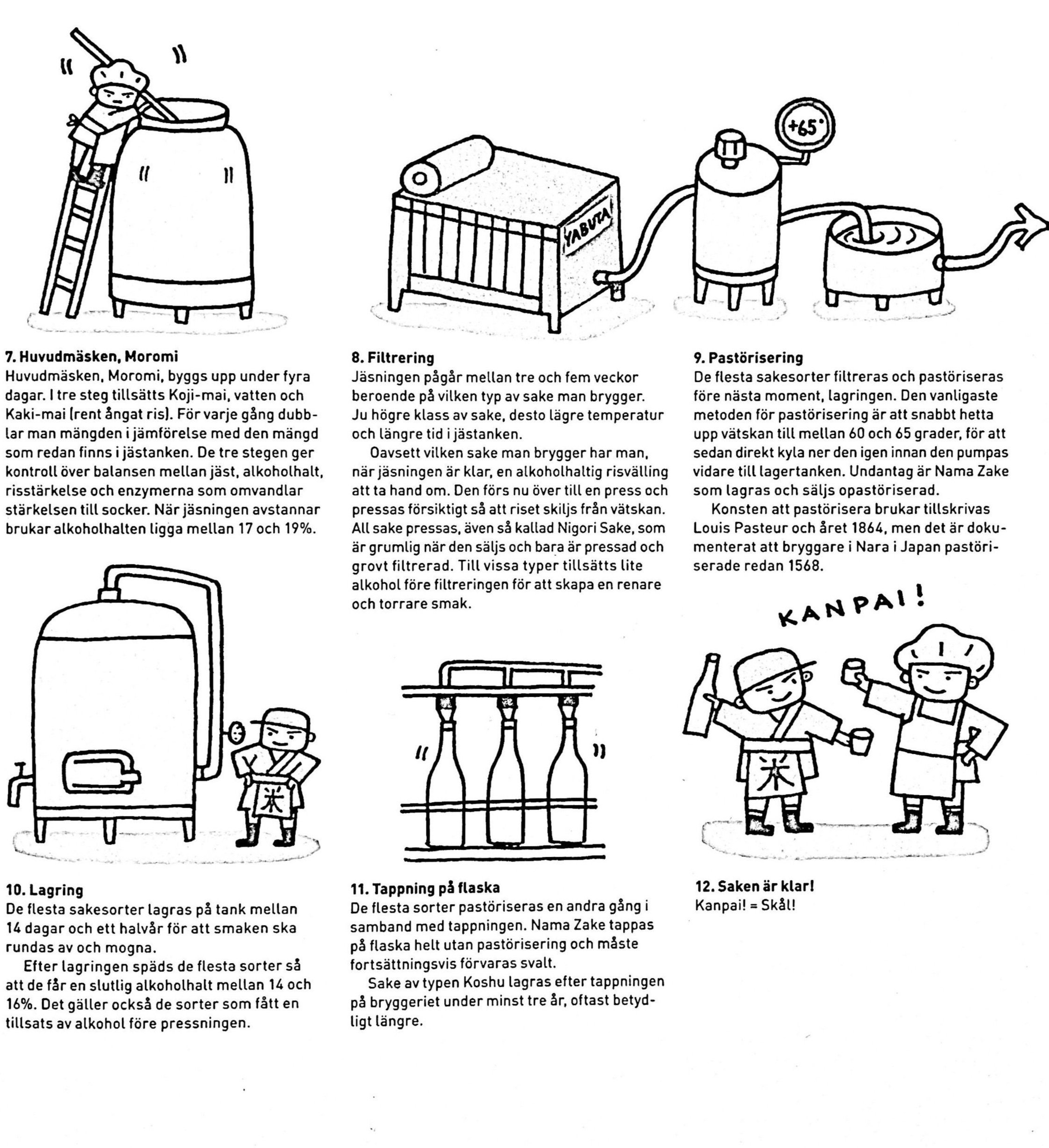A small, but very informative, school of sake.
SAKE HAS BEEN BREWED in Japan for more than two thousand years, but just like when it comes to wine and beer in our part of the world, the quality development has been noticeable from the 1970s onwards. Right now the sake industry is developing extra quickly.
Old brewmasters hand over to a younger generation and the hierarchies are dismantled. Just fifteen years ago, it was normal for breweries to be run by an owner, ”Kuramoto”, who had a brewmaster, ”Toji”, under him.
Today, it is becoming more common for the brewmaster and owner to be the same person.
The result is shorter decision paths and rapid product development. That trend has led to that really high quality sake is increasing in sales, while simple sake has decreased in volume.
WHAT IS SAKE?
Sake is a fermented alcoholic beverage made from rice, water, sweet rice and yeast.
To be able to convert the starch in the rice to fermentable sugar it is also needed mold spores, called ”Koji-kin” in Japanese and “Aspergillus Oryzae” in Latin. A total of four ingredients are used to brew sake; rice, water, yeast and Koji-kin.
There are over 120 types of rice approved for sake brewing. The most exclusive rice type is called ”Yamada-Nishiki” and it is also the most common. The rice mainly contributes with fermentable sugar but also, in combination with the yeast and the water, it develop flavors during the brewing process.
But it is mostly about the yeast, in Japanese ”Kobo”, it has the most important role in creating the taste and aromas of a sake. It is the yeast that forms most of the aromas, especially in the fruity and floral direction.
About 80% of sake consists of water, the source of the water are therefore also of great importance for the taste of the final product.
The aroma of a sake brewed on hard water often contains components such as green apples, unripe pears and citrus fruits, the taste is usually dry and high in mineral.
Sake brewed with soft water has a more rounded flavor, usually more notes of banana, melon and tropical fruits, also a more present umami.
FUTSU-SHU, GINJO & JUNMAI DAIGINJO.
WHAT IS IT?
Ordinary and Premium.
To begin with, sake is divided into two main categories: ordinary and premium. Ordinary sake is called in Japanese “Futsu-shu” and premium sake “Tokutei-meisho-shu”. The most interesting varieties are available in the premium segment.
Junmai and Non Junmai.
Premium quality sake is divided into two main types: “Junmai”and “Non-Junmai”. Junmai means "pure rice" and is sake brewed from the four ingredients rice, water, yeast and the mold spore “Koji-kin”.
For sake that is not “Junmai”, a little alcohol has been added before pressing, not during the brewing process itself. It is done to create a drier taste, not to increase the alcohol content.
Almost all sake has an alcohol level between 14 and 16% after pressing and filtering.
Rice Polishing Ratio.
“Junmai” and “Non-Junmai” are in turn divided into different classes depending on how much of the rice grain remains after polishing. The less that remains, the more elegant the taste.
The most exclusive class is called “Junmai Daiginjo” or just “Daiginjo” (if a small amount of alcohol has been added before pressing) and is brewed on rice that has been polished so that a maximum of 50% remains of the original rice grain. The class below is called “Junmai Ginjo”, respectively only Ginjo if alcohol has been added. The rice is polished so that a maximum of 60% of the original rice grain remains.
The next class on the "pure rice" side is just called “Junmai”. Here it is enough if the rice is polished to 90%. On the “Non-Junmai” side, the corresponding class is called “Honjozo”, but here there is a requirement that the rice has been polished down so that the maximum is 70% of the original size of the grain. For “Futsu-shu” (ordinary sake) - there is no requirements of the polishing ratio.
IMPORTANT FOR TASTE.
“Kimoto”, “Yamahai” and “Sokujo-moto” are three different methods used to start fermentation. ”Sokujo-moto” is most common and fastest, and produces light, clean flavors, lactic acid is added with the yeast into the mash. Kimoto and Yamahai add more complexity and umami to the taste, both have naturally added lactic bacteria from the surroundings.
Kimoto is the predecessor of Yamahai, the difference is that with the Kimoto method you work the fermentation starter, the “Shubo”, with wooden poles, with the Yamahai method you leave the mash to rest.
Both takes approx 30 days to finish, as the faster Sokujo-moto only takes 7-12 days.
Sometimes yeast is not even added, usally at the Kimoto and Yamahai method.
The fermentation is instead started by yeast particles that are in the air and on the equipment, so-called “wild fermentation”.
Kimoto, Yamahai and wild fermentation are particularly popular with progressive small breweries on the cutting edge, but is today seen in many types of breweries.
UNIQUE IN MANY WAYS!
Sake is often called rice wine, but that is misleading. During winemaking, flavorings, acids, tannins, dyes, fermentable sugar and liquid come from the grape. For sake, all liquid is added in the form of water while the yeast develops most of the flavor.
The rice mainly contributes fermentable sugar. Since sake is not distilled, there are no similarities to spirits either. Sake is unique and constitutes a category of its own among the world's beverages. SAKE IS A RICE BREW.
日本酒 = “Nihonshu”, is the term for rice brew In Japan, the term "sake" just means "alcohol" and can refer to both beer , spirits and wine.
When a Japanese specifically talks about the alcohol fermented from rice, it is the term “Nihonshu” they use, which literally means “Japanese alcohol made from rice". Nihonshu is today a protected designation of origin which guarantees that all raw materials come from Japan.
TIP! When you order sake at a bar or restaurant in Japan, you say: "Suimasen, nihonshu o kudasai!("Excuse me, could I have sake!).TIP!
Also unique for sake, is the mold spore “Koji-kin”, in Latin; “Aspergillus oryzae” who has a decisive importance when brewing sake. Koji-kin eats its way into the rice grains and forms enzymes that convert the starch in the rice into fermentable sugar. This process is started before the fermentation starts, but continues during the fermentation, which means that the yeast is constantly fed with new sugar that it can convert into alcohol. This process is unique to sake and is called multiple parallel fermentation.
Kanpai! "= Cheers, or empty your cup!






